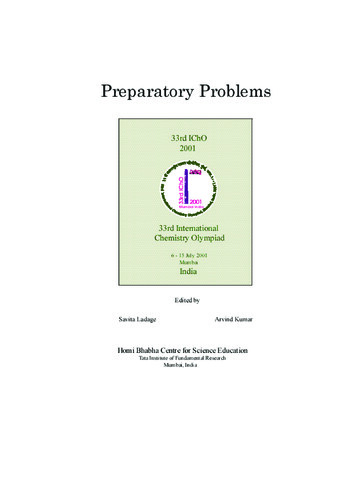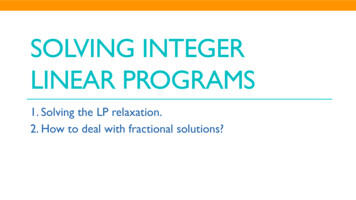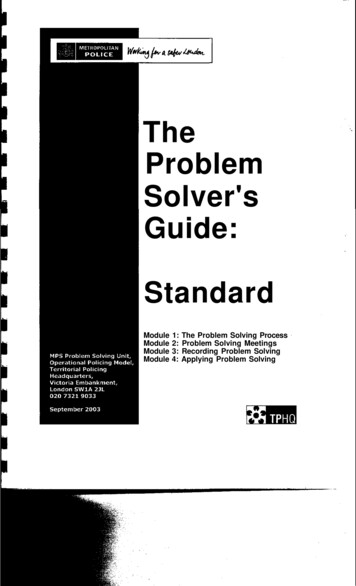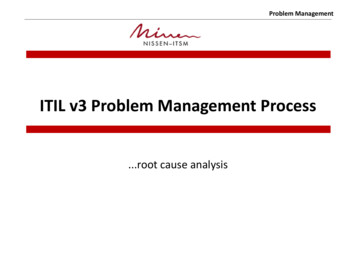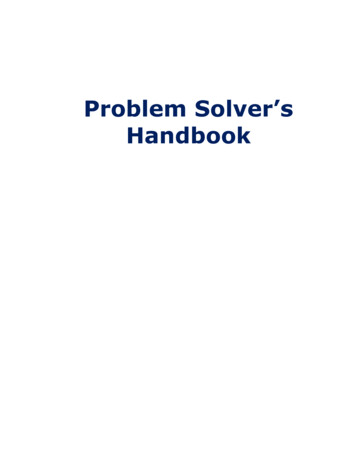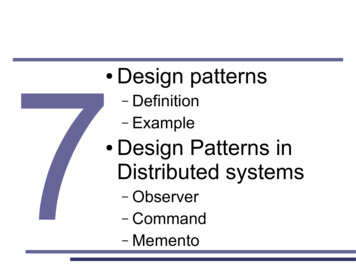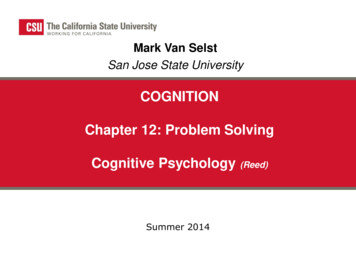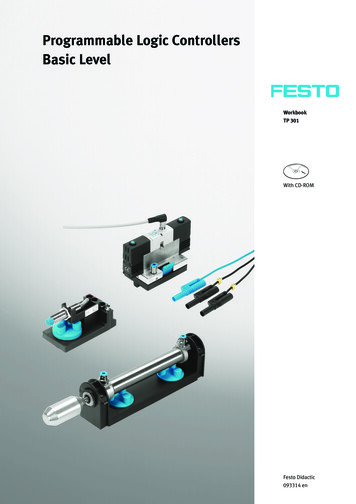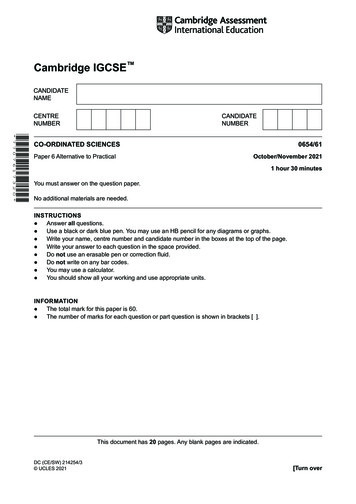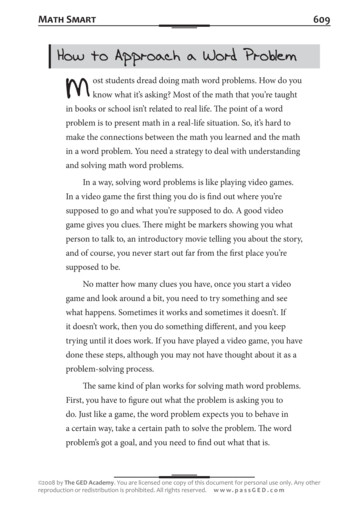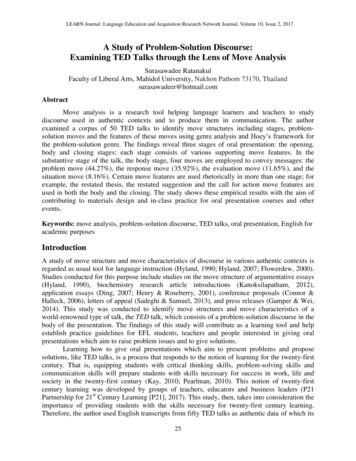
Transcription
LEARN Journal :Language Education and Acquisition Research Network Journal, Volume 10, Issue 2, 2017A Study of Problem-Solution Discourse:Examining TED Talks through the Lens of Move AnalysisSurasawadee RatanakulFaculty of Liberal Arts, Mahidol University, Nakhon Pathom 73170, Thailandsurasawadeer@hotmail.comAbstractMove analysis is a research tool helping language learners and teachers to studydiscourse used in authentic contexts and to produce them in communication. The authorexamined a corpus of 50 TED talks to identify move structures including stages, problemsolution moves and the features of these moves using genre analysis and Hoey’s framework forthe problem-solution genre. The findings reveal three stages of oral presentation: the opening,body and closing stages; each stage consists of various supporting move features. In thesubstantive stage of the talk, the body stage, four moves are employed to convey messages: theproblem move (44.27%), the response move (35.92%), the evaluation move (11.65%), and thesituation move (8.16%). Certain move features are used rhetorically in more than one stage; forexample, the restated thesis, the restated suggestion and the call for action move features areused in both the body and the closing. The study shows these empirical results with the aim ofcontributing to materials design and in-class practice for oral presentation courses and otherevents.Keywords: move analysis, problem-solution discourse, TED talks, oral presentation, English foracademic purposesIntroductionA study of move structure and move characteristics of discourse in various authentic contexts isregarded as usual tool for language instruction (Hyland, 1990; Hyland, 2007; Flowerdew, 2000).Studies conducted for this purpose include studies on the move structure of argumentative essays(Hyland, 1990), biochemistry research article introductions (Kanoksilapatham, 2012),application essays (Ding, 2007; Henry & Roseberry, 2001), conference proposals (Connor &Halleck, 2006), letters of appeal (Sadeghi & Samuel, 2013), and press releases (Gamper & Wei,2014). This study was conducted to identify move structures and move characteristics of aworld-renowned type of talk, the TED talk, which consists of a problem-solution discourse in thebody of the presentation. The findings of this study will contribute as a learning tool and helpestablish practice guidelines for EFL students, teachers and people interested in giving oralpresentations which aim to raise problem issues and to give solutions.Learning how to give oral presentations which aim to present problems and proposesolutions, like TED talks, is a process that responds to the notion of learning for the twenty-firstcentury. That is, equipping students with critical thinking skills, problem-solving skills andcommunication skills will prepare students with skills necessary for success in work, life andsociety in the twenty-first century (Kay, 2010; Pearlman, 2010). This notion of twenty-firstcentury learning was developed by groups of teachers, educators and business leaders (P21Partnership for 21st Century Learning [P21], 2017). This study, then, takes into consideration theimportance of providing students with the skills necessary for twenty-first century learning.Therefore, the author used English transcripts from fifty TED talks as authentic data of which its25
LEARN Journal :Language Education and Acquisition Research Network Journal, Volume 10, Issue 2, 2017topics are multi-disciplinary with a strong belief in the “power of ideas to change attitudes, livesand, ultimately, the world” (Technology, Education and Design [TED], 2017). The authorconsiders data from TED talks appropriate as a learning model for oral presentations whichrequire students to use critical thinking, problem-solving and communication skills.Move analysis of problem-solution discourse of different genres has been conducted toexplore the move structure of, for example, newspaper articles (Aghagolzadeh & Khanjani,2011; Ali, 2013) and student writings (Flowerdew, 2003; Galan & Perez, 2003). This research isanother such effort. It was undertaken with the purpose of identifying move structures and movecharacteristics of oral presentations or talks which include problem-solution discourse. Thefindings will benefit EFL learners and materials developers in the development of oralpresentation courses and will build on knowledge in the field of problem-solution discourse andmove analysis.Significance of the studyMost written and spoken problem-solution genres have been studied in depth by linguists. Thestudies revealing linguistic means of identifying problem-solution patterns have focused onclause relations together with their grammatical and lexical signals. As a consequence, patternsof problem-solution discourse including situation, problem, response, and evaluation have beenidentified by linguistic elements (Flowerdew, 2008). However, studies of genre have beenencouraged to involve human activities and to be products of more social construct rather thanonly being products of text types (Tardy, 2006). This study on problem-solution discourseexamining socially popular TED talks was then conducted to study the experience-sharing andknowledge-producing activity which is shaped by human activity.Hyland suggests that acquisition of genre knowledge is an essential element individualsneed to be familiar with in order to understand texts as “socially situated attempts tocommunicate” (Hyland, 2014, p. 40). Genre knowledge will provide a discourse community withan understanding of how a certain discourse is structured to successfully communicate itsmessages and achieve its rhetorical goals. Though it is obvious that genre knowledge of a socialcontext is essential, Swales (1990) emphasized that how a certain genre is organized in a socialcontext has been a problem for non-native learners; there must be an available rhetorical modelto help learners or discourse community members equip themselves with genre knowledge andprovide them with practice guidelines to produce a discourse of their choice. This study isanother attempt offering genre knowledge concerning move structures and move characteristicsof a socially constructed talk including problem-solution discourse.TED talks, a popular public speaking forum invites speakers from all walks of life; thesetalks have gained considerable interest locally and internationally for ideas worth sharing fromthe personal and professional experiences of speakers. This study selected TED talks includingproblem-solution discourse with the aim of finding the move structures that will help preparelearners and practitioners step by step through embedded move features to present and criticallydiscuss issues they deem problematic and reliably propose effective solutions to the problemraised. To achieve this practical goal of giving oral presentations, it is essential for learners andpractitioners to use and develop their critical thinking, problem-solving and communicationskills. As a result, move structures and move characteristics found as the finding of this study canbe used or applied as guidelines for practices and lessons on public and oral presentationfocusing on an issue of problem-solution.26
LEARN Journal :Language Education and Acquisition Research Network Journal, Volume 10, Issue 2, 2017Genre analysisAccording to Coulthard (1994), we cannot always assume that all texts are comprehensiblestraight away since knowledge and ideas are not linear; as a result, messages conveyingknowledge and ideas need to be effectively organized in order to make a non-linear messagefully comprehensible. That is, textual organization plays an important role. In this regard,knowledge of move identification and move structure will effectively guide message sendersthrough the textual organization of a certain genre they need to produce. This will eventuallyhelp shape non-linear forms of knowledge, ideas and information into linear forms.Move realization: a communicative purpose driven analysis“A genre is best conceptualized as goal-directed and functional. Thecommunicative intentions in the genre shape the structure of the genre andprovide it with an inner structure” (Hyland, 2007).Move realization is the practical result of a theoretical process obtained as the product ofgenre analysis using embedded communicative purposes as a means to distinguish and categorizetexts into several moves and move features that actually form texts or certain genres. In otherwords, move structures can be retrieved and reconstructed by using shared communicativepurposes, which is central if move analysis is to identify moves and move features embed intexts (Cohen & Upton, 2009; Hyland, 2007). Move and stage realization can be reliablydescribed since there is a linguistic notion that holds that different moves, move features andstages reveal their distinctive functions and semantic purposes (Cohen & Upton, 2009;Flowerdew, 2000). At the end of move analysis, the findings will show a series of moves andpurposes that the message senders have developed (Hyland, 2014; Paltridge, 2013). Moves,move features and stage realization will then be representative of a certain genre and can be usedto explain the move structures of a genre (Hyland, 1990); for example, problem-suggestionarticles, research grant proposals, business letters, and advertisements.Genre analysis: a context-bound studyGenre analysis is an empirical study of the authentic use of language in a real context(Hyland, 2007). Scholars and those who study genre analysis need to get used to and refer to thecontext in which a genre is produced (Flowerdew, 2000; Hyland, 2007; Hyland, 2014; Paltridge,2013). Paltridge (2001) refers to Bhatia (1993)’s method of intuitively surveying texts; Paltridgeadds that an initial contextual examination of a text is a must and message senders, whether theyare speakers or writers, should make use of the results of the process. Bhatia proposes a list ofquestions which those who study a certain genre use in order to understand and produce the keycontextual characteristics of the genre. Guiding questions to examine a textual context include:what is the purpose of the genre? what is the setting? who are the possible listeners/readers? whatknowledge and information do listeners/readers have about the topic and need to know? what arethe speaker’s/writer’s expertise and experiences related to the topic of the discussion? (Hyland,2007; Paltridge, 2001).Contextual analysis will eventually answer the big question of how to design the textualcontent; that is, what kind of information, stories, statistical data, opinions is included; how muchand in what proportion should a speaker/writer include of each element in a text to achievehis/her purposes (Hyland, 2007). To clarify the question Hyland (2007) raises, if a speaker/writer27
LEARN Journal :Language Education and Acquisition Research Network Journal, Volume 10, Issue 2, 2017masters the contextual characteristics of a genre, we will see different kinds of content in theforms of different moves, in different amounts, and in different orders that a speaker/writer usesto organize texts. The figure below sums up what has just been discussed, the factors governingthe key contextual characteristics and content production in a certain genre.AUDIENCES/READERSPURPOSE who are listeners/readers? To give information? what do they know and To educate?don’t know about the topic? To raise awareness? what should they know about the topic? To call for action? etc.CONTENT selected information and the proportionsSPEAKERS/WRITERSCHANNELS who are speakers/writers? what is the setting of the text? what is their status?(Facebook, internet, paper etc.) what are their expertise and to what extent can the channelexperiences?convey messages?Figure 1. Factors governing key contextual characteristics and content production(Hyland, 2007 ; Paltridge, 2001).Move structure of problem-solution discourse: SPREMichael Hoey proposed a rhetorical structure for problem-solution discourse in 1983.The move structure consists of four moves, the situation, the problem, the response and theevaluation (SPRE). The following shows Hoey’s (1983) problem-solution move structure andgives definitions for each move (Hoey, 2001; Salkie, 1997).1. Situation: the situation move is primarily used to provide background information preparinglisteners/readers to be able to understand issues involved in the discourse that follows.2. Problem: the problem move is used principally to discuss obstacles, needs, restrictions,drawbacks, dilemmas in focus in the discourse.3. Response: the response move presents solutions to the problem; for example, how toovercome obstacles, how to respond to needs, how to remove restrictions, and how to resolvedilemmas.28
LEARN Journal :Language Education and Acquisition Research Network Journal, Volume 10, Issue 2, 20174. Evaluation: the evaluation move is used to introduce positive and negative consequences ofthe speaker’s/writer’s proposed suggestions as well as to discuss the advantages anddisadvantages of each suggestion when there is more than one proposed suggestion.Studies confirm that the SPRE move structure does not occur in a fixed and predictableorder; that is, there is no one-to-one mapping of communicative functions of move structuresembedded in a problem-solution text (Ali, 2013; Flowerdew, 2003; Hoey, 2001; Jordan, 1984;Paltridge, 1996). According to Hoey (1986), the lack of a one-to-one mapping forcommunicative functions does not imply a communication breakdown. Hoey explains that howlisteners/readers perceive the order of messages or move order matters (Hoey, 1986); that is, thereal nature of the pattern depends on whether messages are fully comprehended bylisteners/readers, not a particular pattern applied to a certain genre.Hoey’s organizational pattern for problem-solution discourse (1983), consisting ofsituation, problem, response, and evaluation (SPRE), can be applied to several kinds of genre ortext types. The SPRE move structure has been used in various discourse types from opinionarticles discussing problems and proposing solutions to business and in organizationalcommunications including business proposals, letters to solve conflicts, letters ofrecommendation, advertising brochures, and leaflets. These texts are designed using the sameSPRE framework (Jordan, 1984). See the example below:A letter to solve a conflict (Farkas, 2016)1. Situation: Your firm and I have joint use of a single parking lot.2. Problem: Your employees start work before ours and fill all the spaces.3. Response: Limit your employee’s use of the parking lot.4. Evaluation : Work with us to solve the problem in a cooperative manner. Otherwise we willtake legal action.In this study, the move structure of “SPRE” was used to identify the rhetorical patterns ofpublic oral presentations, TED talks which have never been before examined using an analytical“move analysis.”MethodologyData collectionThis study is a corpus-driven analysis of TED talks which include a discussion of problem issuesleading to solutions. Fifty transcripts of TED talks given in English, with lengths of 10-20minutes and with a total of approximately 120,000 words, were purposively sampled from thefifteen most popular talks of all time, ten popular talks and twenty-five other talks. The topics ofthe fifty talks are multi-disciplinary and cover a wide range of eight issues including success andhappiness in life and in work, communication, science, psychology, education, self and identity,and living in society, with six or seven talks for each issue, making up a total of 50 talks. Ananalysis of these fifty samples suggested certain move features under the opening, the closingand the body including the situation, the problem, the response and the evaluation (SPRE)moves. The fifty speakers were of different nationalities and careers; for example, cybersecurityexperts, computer scientists, scientists, writers, educators, a designer, a psychologist, a model, aTV host, and a comedian.29
LEARN Journal :Language Education and Acquisition Research Network Journal, Volume 10, Issue 2, 2017Data analysisThe move analysis of the TED talks was based on the notion of shared communicative purposewhich helps determine what a certain genre consists of (Hyland, 1990). The embeddedcommunicative purposes in a discourse or a text are used to divide a text into different moves;that is, a move is realized according to a communicative purpose connected with each move.This is the basic purpose-based or purpose-driven genre analysis method. In this study, theauthor also used Hoey’s (1983) framework of analysis to examine problem-solution discourse.Similarly, the problem-solution texts, or transcripts of the TED talks used in this study, wereanalyzed and the moves were identified and classified as situation moves, problem moves,response moves, or evaluation moves (SPRE moves) according to their communicative purposes.Since the data consists of transcripts of oral presentations, it was necessary for the author towatch all the TED talks broadcast on YouTube in order to understand what is really going on inthe talks; for example, video clips, graphic materials and speakers’ gestures and hand signalsused during the talks.Data analysis was conducted in two steps. The first step was to divide the data into thethree stages found in oral presentations, the opening, the body and the closing, by using the basicpurpose-based genre analysis method. The second step was to classify each stage according toSPRE moves and move features using 1) Hoey’s (1983) analytical framework for problemsolution discourse dividing texts into four moves: the situation move, the problem move, theresponse move and the evaluation move (SPRE) and 2) the basic purpose-based genre analysismethod. To illustrate the point, in the second step, the author classified each stage, the opening,the body and the closing stages, by using the two frameworks. The data divided into, first, SPREmoves and, second, move features according to the three stages. All the SPRE moves and themove features were the results of the analysis in the second step. A quantitative analysis,including the total number, the average value, the percentage and ratio, was employed to showmove frequency and occurrence.The author reanalyzed and recoded all the data two months later using the same analyticalframeworks. The result of intra-coder reliability was 91.10%. Then twenty percent of the data, orten talks, was analyzed and inter-coded by a native speaker scholar of EFL who is familiar withareas of English for academic purposes, move analysis and discourse analysis. The inter-coderreliability rate was 81.06%.ResultsMove identification and analysisThe two steps of analysis, a basic purpose-based genre analysis and Hoey’s analytical frameworkfor problem-solution discourse, result in three sets of findings. The first set of results involvesdividing TED talk transcripts into three stages, the opening, the body and the closing. The secondset of results includes the four different moves of the problem-solution genre, which are thesituation, the problem, the response and the evaluation (SPRE moves) embedded in the body ofthe text. The third and last set of results includes, first, move features in all SPRE moves in thebody and, second, move features in the opening and the closing stages as well as, third and last,definitions of all move features in TED talks.Table 1 below shows a list of the three stages of talks, the four moves of problemsolution discourse, all move features, definitions of these features, and sample statements.30
LEARN Journal :Language Education and Acquisition Research Network Journal, Volume 10, Issue 2, 2017Table 1Moves of problem-solution talks and their definitionsStage: MoveDefinitionMove featureA. Opening stage1. GreetingSample statementThe speaker greets the audienceA greeting from the talk “Do schools kill creativity?” by Ken RobinsonGood morning. How are you?2. Self-introductionSample statementThe speaker introduces herself/himself. It can be in an attention-getting mannerA self-introduction from the talk “Battling bad science” by Ben Goldacre DebunkerI’m a doctor, but I kind of slipped sideways into research, and now I’m an epidemiologist.3. Attention getter (Hook) The speaker gets the audience involved in the talk at the opening to capture the audience’s attentionSample statementAn attention getter from the talk “How to make stress your friend” by Kelly McGonigalI have a confession to make. But first, I want you to make a little confession to me. In the past year,I want you to just raise your hand if you’ve experienced relatively little stress. Anyone? How abouta moderate amount of stress? Who has experienced a lot of stress? Yeah. Me too.4. Lead-inSample statementThe speaker provides brief information to lead the audience to the body and to the main content ofthe talkA lead-in from the talk “How to raise successful kids – without over-parenting”by Julie Lythcott-HaimsYou know, I didn’t set out to be a parenting expert. In fact, I’m not very interested in parenting, perse. It’s just that there’s a certain style of parenting these days that is kind of messing up kids,impeding their chances to develop into themselves. There’s a certain style of parenting these daysthat’s getting in the way.5. Topic of talkSample statementThe speaker states the topic or focus of the talkTopic of the talk from “Eight secrets of success” by Richard St. JohnHere we are, seen years, 500 interviews, and I’m going to tell you what really leads to success andmakes TEDsters tick.6. Purpose of talkSample statementThe speaker identifies the purpose or significance of the talkPurpose of the talk from “How to make stress your friend” by Kelly McGonigalFor years, I’ve been telling people, stress makes you sick. It increases the risk of everything from thecommon cold to cardiovascular disease. Basically, I’ve turned stress into the enemy. But I havechanged my mind about stress, and today, I want to change yours.Stage: MoveDefinitionMove feature7. Thesis of talkSample statementThe speaker states clearly what the thesis or the main idea of the talk isThesis of the talk from “I’m not your inspiration, thank you very much” by Stella Young31
LEARN Journal :Language Education and Acquisition Research Network Journal, Volume 10, Issue 2, 2017We’ve been sold the lie that disability is a Bad Thing, capital B, capital T. It’s a bad thing, andto live with a disability makes you exceptional. It’s not a bad thing, and it doesn’t make youexceptional.8. Overview of talkSample statementThe speaker gives an overview of the talk in order to prepare the audience and to help theaudience see the organization of the talk clearlyOverview of the talk from “Battling bad science” by Ben Goldacre DebunkerWhat I’m going to show you is all of the main things, all of the main features of my discipline,evidence-based medicine. And I will talk you through all of these and demonstrate how theywork, exclusively using examples of people getting stuff wrong.B1. Body stage: Situation move1. Background information The speaker presents stories, including the speaker’s stories, facts, information about thesituation or conditions or issues in order to link to the problem issues the speaker raisesSample statementBackground information for the talk “Do schools kill creativity?” by Ken RobinsonI heard a great story recently – I love telling it – of a little girl who was in a drawing lesson. Shewas six, and she was at the back, drawing, and the teacher said this girl hardly ever paidattention, and in this drawing lesson, she did. The teacher was fascinated. She went over to her,and she said, “What are you drawing?” And the girl said, “I’m drawing a picture of God.” Andthe teacher said, “But nobody knows what God looks like.” And the girl said, “They will, in aminute.”B2. Body stage: Problem move1. Background of problemSample statementThe speaker presents information and background information showing how problems underdiscussion start and have developedBackground to the problem from the talk “Refugees have the right to be protected”by Antonio GuterresThe war in Syria has been happening for five years. Millions of refugees are in camps andvillages and towns around Syria. You have yourself warned about the situation and about theconsequences of a breakdown of Libya, for example, and yet Europe looked totally unprepared.Well, unprepared because divided, and when you are divided, you don’t want to recognize thereality. You prefer to postpone decisions, because you do not have the capacity to make them.And the proof is that even when spike occurred, Europe remained divided and was unable to putin place a mechanism to manage the situation.2. Problem issuesSample statementThe speaker describes details about the problem or conditions resulting in negative effects andcalls for a solution or a changeProblem issue from the talk “Refugees have the right to be protected” by Antonio GuterresThe world is abandoning us.32
LEARN Journal :Language Education and Acquisition Research Network Journal, Volume 10, Issue 2, 2017Stage: MoveDefinitionMove feature3. Getting audiencesinvolved in the problemSample statementThe speaker presents information related to the problem to convince the audience that the issuepresented is a problem or it affects themGetting the audience involved in the problem from the talk “Where is cybercrime really comingfrom?” by Caleb BarlowSo how are we going to stop this? It’s not like we’re going to be able to identify who’sresponsible – remember, they operate with . I would propose that we need a completely newapproach. And that approach needs to be centered on the idea that we need to change theeconomics for the bad guys. And to give you a perspective on how this can work, let’s think ofthe response we see to a healthcare pandemic: SARS, Ebola, bird flu, Zika. What is the toppriority?4. Cause of problemSample statementThe speaker examines the causes leading to certain problem conditionsCause of the problem from the talk “Refugees have the right to be protected” by Antonio GuterresAnd then the trigger was when all of a sudden, international aid decreased. The World Food Programwas forced, for lack of resources, to cut by 30 percent food support to the Syrian refugees. They’renot allowed to work, so they are totally dependent on international support.5. Result of problemSample statementThe speaker discusses negative results of the problemResult of the problem from the talk “How to raise successful kids—without over-parenting”by Julie Lythcott-HaimsAnd here’s what it feels like to be a kid in this checklisted childhood. First of all, there’s no time forfree play. There’s no room in the afternoons because everything has to be enriching, we think.6. Thesis of talkSample statementThe speaker states clearly what the thesis or the main idea of the talk isThesis of the talk from “Three lessons on success from an Arab businesswoman” by Leila HoteitI would like to think that we (Arab women) poor, oppressed women actually have some useful,certainly hard-earned lessons to share, lessons that might turn out useful for anyone wishing to thrivein the modern world. Here are three of mine.7. Ending the problem The speaker shows signs of ending discussion of the problem by signposting s/he is going to suggestsolutionsSample statementEnding the problem from the talk “The power of vulnerability” by Brene BrownAnd you know how I feel about vulnerability. I hate vulnerability. And so I thought, this is my chanceto beat it back with my measuring stick. I’m going in, I’m going to figure this stuff out, I’m going tospend a year, I’m going to totally deconstruct shame, I’m going to understand how vulnerabilityworks, and I’m going to outsmart it. So I was ready, and I was really excited.33
LEARN Journal :Language Education and Acquisition Research Network Journal, Volume 10, Issue 2, 2017Stage: MoveDefinitionMove featureB3. Body stage: Response move1. Preparing audiences The speaker tries to get the audience involved in suggestions by providing informationfor suggestionas a transition or a bridge to suggestions s/he is going to giveSample statementPreparing audience for a suggestion from “How to speak so that people want to listen”by Julian TreasureYou have an amazing toolbox. This instrument is incredible, and yet this is a toolbox that very fewpeople have ever opened. I’d like to have a little rummage in there with you now and just pull a fewtools out that you might like to take away and play with, which will increase the power of yourspeaking.2. Beginning of solution The speaker tells a story about how s/he started to solve the problemSample statementBeginning of the solution from the talk “How to learn from mistake?” by Diana LaufenbergWe’d never done this before, and they didn’t know exactly how to do it. They can talk – they’re verysmooth, and they can write very, very well, but asking them to communicate ideas in a different waywas a little uncomfortable for them. But I gave them the room to just do the thing.3. SolutionSample statementThe speaker suggests solutions to the problem under discussion or shares solutions or stories aboutwhat s/he did or learned or found from his/her experiencesSolution from the talk “How to learn from mistake?” by Diana Laufenberg“Go figure it out. Let’s see what we can do.” And the student that persistently turns out the bestvisual product did not disappoint. This was done in like two or three days. And this is the work of thestudent that consistently did it.4. SuggestionSample statementThe speaker suggests possible ways to solve the problem under discussion but s/he has not yet usedthe suggestions to solve problemsSuggestion from the talk “Why we do w
of a socially constructed talk including problem-solution discourse. TED talks, a popular public speaking forum invites speakers from all walks of life; these talks have gained considerable interest locally and internationally for ideas worth sharing from the personal and professional experiences of speakers. This study selected TED talks including
